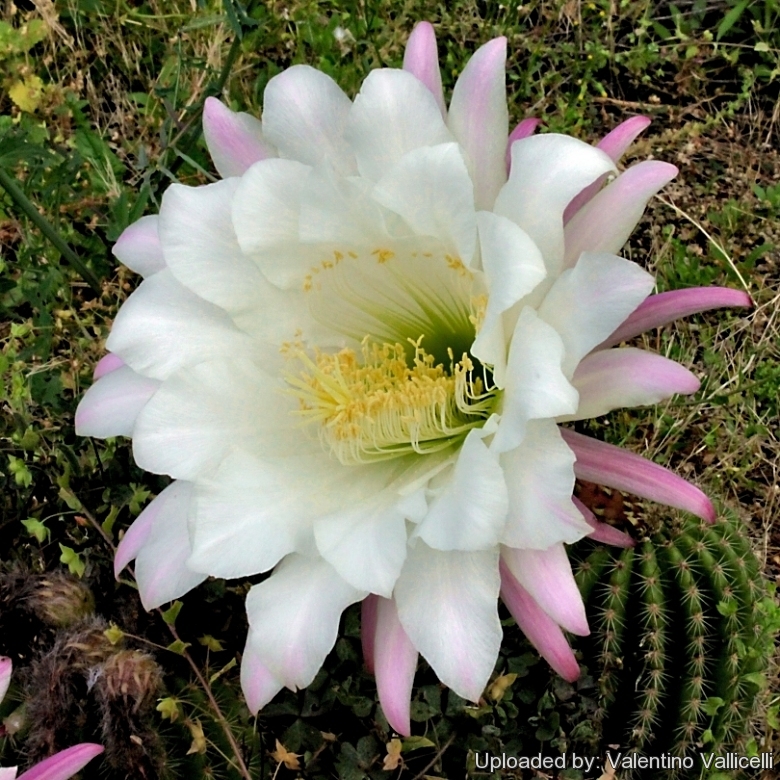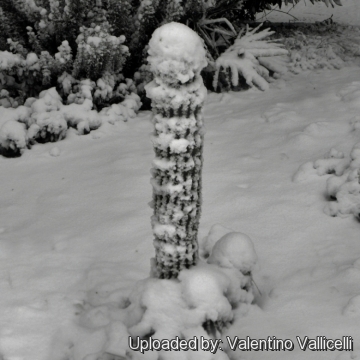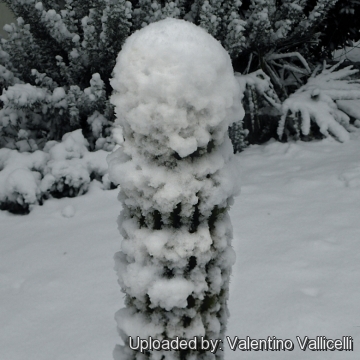Accepted Scientific Name: Echinopsis schickendantzii F.A.C.Weber in Bois
Dict. Hort. [Bois] 1: 473. 1896 Bois

Cereus schickendantzii (Echinopsis schickendantzii) Photo by: Valentino Vallicelli
Origin and Habitat: Northwestern Argentina (Catamarca, Jujuy, Salta, Tucumán), and in Bolivia (Tarija, Chuquisaca and Santa Cruz).
Type locality: Tucuman, Argentina.
Altitude: 1200 to 3200 meters above sea level.
Habitat: The species has a patchy distribution but is locally abundant in high altitude grasslands and yunga forest.
Synonyms:
See all synonyms of Echinopsis schickendantzii
back
Accepted name in llifle Database:Echinopsis schickendantzii F.A.C.Weber in BoisDict. Hort. [Bois] 1: 473. 1896Synonymy: 9
back
Description: Echinopsis schickendantziiSN|16016]]SN|16016]] (best known as: Trichocereus schickendantziiSN|16017]]SN|16017]]) redeems its unremarkable vegetative aspect when it blooms in spring and summer. Is not fragrant but is probably one the most beautiful of the genus. The beautiful large cup-shaped white flowers are about 20 long and cluster on top and remain open at times for three days.
Habit: Plants slender, erect, shrubby, simple or more often forming wide clumps. When offshoots spring from the base of the plant, obviously the natural way is for them to grow in clusters, and very often they make their own roots and take on growth independently of the parent stem.
Stem: Cylindrical to oblong, very soft-fleshed, freely branching from the base, 15 to 75 cm high, 5-7 cm in diameter, dark green, shiny, light green.
Areoles: very close set, sometimes touching.
Ribs: 14 to 18, low, 5 mm high, somewhat crenate and notched.
Spines: Yellowish, flexible, all spines 5 to 10 mm long;
Radial spines: at first 9, in age more numerous.
Central spines: 2 to 8 (mostly 4)
Flowers funnelform: Nocturnal, several at a time from the top of the plant, tubular to
funnelform, inodorous (but some reports say it is scented), 20 to 22 cm long; scales on the ovary and flower-tube with dense black hairs; inner perianth-segments acute, oblong, white. Flower-bud pointed, covered with black wool.
Blooming season: Spring to early summer. Flowers lasts for several days.
Fruit: Edible, agreeable.
Bibliography: Major references and further lectures
3) Edward Anderson “The Cactus family” Timber Press, Incorporated, 2001
4) James Cullen, Sabina G. Knees, H. Suzanne Cubey "The European Garden Flora Flowering Plants: A Manual for the Identification of Plants Cultivated in Europe, Both Out-of-Doors and Under Glass" Cambridge University Press, 11/Aug/2011
2) David R Hunt; Nigel P Taylor; Graham Charles; International Cactaceae Systematics Group. "The New Cactus Lexicon" dh books, 2006
5) Curt Backeberg “Die Cactaceae: Handbuch der Kakteenkunde,” Volume 2 G. Fischer, 1959
7) Walter Rausch “Lobivia: The Day Flowering Echinopsidinae from a Geographical Distribution Point of View” Volumes 1-3 R. Herzig, 1975
8) N. L. Britton and J. N. Rose “The 'Cactaceae', Descriptions and Illustrations of Plants of the 'Cactus' Family” volume 2 Carnegie Institution, 1920
9) John Borg "Cacti: a gardener's handbook for their identification and cultivation" Blandford P., 1970
10) Willy Cullmann, Erich Götz (Dozent Dr.), Gerhard Gröner “The encyclopedia of cacti” Timber Press, 1987
11) H. Peter Loewer “The Evening Garden” Macmillan Pub., 1993
12) Vera Higgins “Cactus Growing for Beginners” Blandford Press, 1964
13) Demaio, P., Lowry, M., Ortega-Baes, P., Perea, M. & Trevisson, M. 2013. Echinopsis schickendantzii. In: IUCN 2013. “IUCN Red List of Threatened Species.” Version 2013.1. <www.iucnredlist.org>. Downloaded on 31 October 2013.
 Cereus schickendantzii (Echinopsis schickendantzii) Photo by: Valentino Vallicelli
Cereus schickendantzii (Echinopsis schickendantzii) Photo by: Valentino Vallicelli Cereus schickendantzii (Echinopsis schickendantzii) Photo by: Valentino Vallicelli
Cereus schickendantzii (Echinopsis schickendantzii) Photo by: Valentino Vallicelli Cereus schickendantzii (Echinopsis schickendantzii) Photo by: Valentino Vallicelli
Cereus schickendantzii (Echinopsis schickendantzii) Photo by: Valentino Vallicelli Cereus schickendantzii (Echinopsis schickendantzii) Photo by: Valentino Vallicelli
Cereus schickendantzii (Echinopsis schickendantzii) Photo by: Valentino VallicelliCultivation and Propagation: Trichocereus schickendantziiSN|8650]]SN|16017]] is a a much decorative frost hardy cactus easily found in cultivation and grows virtually anywhere. It is a summer grower species that offers no cultivation difficulties. It can be overwintered outdoors if sheltered from rain and severe frosts.
Soil: Use a very a particularly draining substratum, as it is very sensitive to rottenness when in presence of humidity and low temperatures and let the soil dry out between waterings, since it's natural habitat is in volcanic soil, it has adapted to more acidic conditions.
Repotting: Repot in the spring, when their roots become cramped. Generally, they should be repotted every other year in order to provide fresh soil. After repotting, do not water for a week or more. Needs a large pot to accommodate a large root system.
Water: In summer, during the vegetative period, it must be regularly watered, but allowing the substratum to completely dry up before irrigating again (but do not overwater). In winter, it’s to be kept dry. Preferable not to water on overcast days, humid days or cold winter days.
Hardiness: It is a quite frost resistant cactus, hardy to - 10° C (or less if very dry). However in cultivation it is better not to expose it to temperatures lower than -0° C, even if in an aerated and protected location, in order to avoid the formation of anti-aesthetic spots on the epidermis. In presence of high atmospheric humidity avoid any frost as it is particularly sensitive to root rot.
Exposure: Outside full sun or afternoon shade, inside needs bright light, and some direct sun, but, as a former mountain dweller, does not care for extremely high temperatures in summer.
Use: It is suitable for small “desert” gardens, in association with other xerophytes. Where the open air cultivation is not possible due to the climate, it is to be cultivated in pot in order to shelter it in winter.
Grafting stock: Trichocereus schickendantziiSN|16017]]SN|16017]] is often used instead of Trichocereus spachianusSN|16017]]SN|8650]] as a rather thick stock.
Propagation: By seeds and by cuttings, provided left drying up well, in summer.















